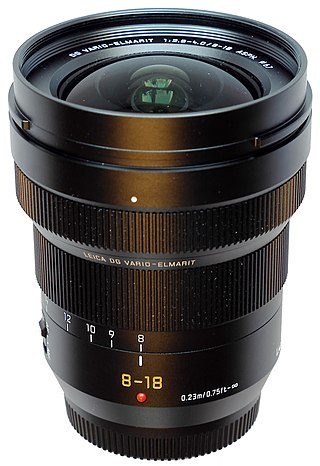

The name Elmarit is used by Leica to designate camera lenses that have a maximum aperture of f/2.8.


The name Elmarit is used by Leica to designate camera lenses that have a maximum aperture of f/2.8.
The Elmarit is a derivation of the Elmar. Confusingly not all f/2.8 lenses are Elmarits. The 50 mm f/2.8 collapsible, manufactured until 2007, was designated an Elmar rather than an Elmarit. [1]
The Elmarit are popular lenses for extreme focal lengths: 21 mm, 24 mm, 28 mm and 90 mm. The Elmarit has also come in 135mm super-telephoto. [2]
The Elmarit are behind the Summicron and the Summarit lenses. Only the Elmar and most Summaron lenses have a smaller f-number.

Leica Camera AG is a German company that manufactures cameras, optical lenses, photographic lenses, binoculars, and rifle scopes. The company was founded by Ernst Leitz in 1869, in Wetzlar, Germany. The name Leica is derived from the first three letters of the founder's surname (Leitz) and the first two of the word camera: lei-ca.

The Four Thirds System is a standard created by Olympus and Eastman Kodak for digital single-lens reflex camera (DSLR) and mirrorless camera design and development.

Macro photography is extreme close-up photography, usually of very small subjects and living organisms like insects, in which the size of the subject in the photograph is greater than life size . By the original definition, a macro photograph is one in which the size of the subject on the negative or image sensor is life size or greater. In some senses, however, it refers to a finished photograph of a subject that is greater than life size.

The Pentax K-mount, sometimes referred to as the "PK-mount", is a bayonet lens mount standard for mounting interchangeable photographic lenses to 35 mm single-lens reflex (SLR) cameras. It was created by Pentax in 1975, and has since been used by all Pentax 35 mm and digital SLRs and also the MILC Pentax K-01. A number of other manufacturers have also produced many K-mount lenses and K-mount cameras.
Walter Mandler was a lens designer of Ernst Leitz Canada in Midland, Ontario. Mandler is credited with the design of more than 45 Leica lenses for the Leica rangefinder cameras and Leica SLR cameras.
Cosina Voigtländer refers to photographic products manufactured by Cosina under the Voigtländer name since 1999. Cosina leases rights to the Voigtländer name from RINGFOTO GmbH & Co. ALFO Marketing KG in Germany. Cosina Voigtländer products have included 35mm film SLR and rangefinder camera bodies, and lenses for the M39 lens mount, M42 lens mount, Leica M mount, and other lens mounts.
The Panasonic Lumix 45mmf/2.8 lens is a macro lens for Micro Four Thirds system cameras. It is co-branded between Leica and Panasonic, built in Japan under Leica management.

The name Summicron is used by Leica to designate camera lenses that have a maximum aperture of f/2 after 1953 and to present day.

The Leica SL is a full-frame mirrorless interchangeable-lens camera announced by Leica Camera AG on 20 October 2015. The SL is promoted as a camera system for professional applications. Beside the Leica S-System, the Leica SL-System is the 2nd professional camera system in the company's product portfolio.

Nocticron is the brand name of Leica lenses with an extreme speed of f/1.2. Because of the large aperture size and its image stabilisation system it is possible to take images with relatively short exposure time especially in available light situations. Together with the high number of nine diaphragm blades the lens creates a strong and pleasant bokeh.
The Panasonic Leica D Vario-Elmar 14-150mm F3.5-5.6 Asph Mega OIS is an interchangeable camera lens announced by Panasonic on March 7, 2007. Since it has been released, it is only produced in small qualities, this makes this product quite special. It features the Four Third Systems to assure its compatibility with different camera models.

The Panasonic Leica D Vario-Elmarit 14-50mm F2.8-3.5 ASPH Mega OIS is an interchangeable camera lens announced by Panasonic on February 26, 2006. It was the first Leica lens with optical image stabilisation.

The Panasonic Leica DG Vario-Elmar 100–400 mmf/4.0-f/6.3 lens is a digital compact telephoto zoom lens for Micro Four Thirds system cameras. It is a varifocal lens branded with the German label Leica, but is currently manufactured in China by Panasonic, previously Japan.

The Leica L-Mount is a bayonet mount developed by Leica Camera AG for interchangeable-lens autofocus digital cameras.

The Panasonic Leica DG Vario-Elmarit 8–18 mmf/2.8-f/4.0 lens is a digital compact ultra wide angle lens for Micro Four Thirds system cameras. It is a varifocal lens branded with the German label Leica, but manufactured by Panasonic in Japan.

The name Summilux is used by Leica and Panasonic Lumix to designate camera lenses that have a maximum aperture of less than f/2, typically f/1.4, but greater than f/1.0. The lens has been in production since 1959 and carries on to the present day.

The name Summarit is used by Leica to designate camera lenses that have a maximum aperture of f/2.4. The name has been in used since 1949.

The name Elmar is used by Leica to designate camera lenses of four elements that have a maximum aperture of f/3.98 or f/4.0.
The Leica S-System is a medium format digital single lens reflex camera system introduced by Leica Camera in 1996. Beginning with the Leica S1, a prototype top-end studio digital camera unveiled at Photokina 1996. It went into production at the end of 1997.